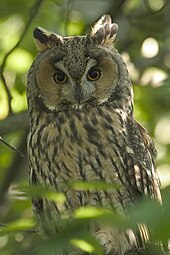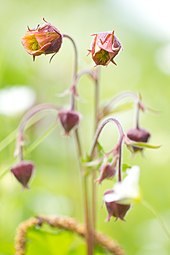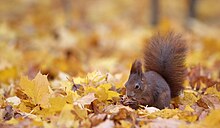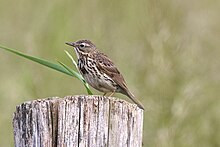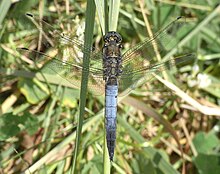Saurasen near Schweinsberg
|
Saurasen near Schweinsberg
|
||
| location | Hessen , Germany | |
| surface | 13.59 hectares | |
| Identifier | 1534012 | |
| WDPA ID | 165340 | |
| FFH area | 13.59 hectares (fully included) | |
| Bird sanctuary | 13.59 hectares (fully included) | |
| Geographical location | 50 ° 46 ' N , 8 ° 58' E | |
|
|
||
| Setup date | 1985 | |
| administration | Regional council of Giessen | |
The Saurasen near Schweinsberg is an alder-ash alluvial forest and species-rich wetland on the north-eastern edge of the urban area of Schweinsberg an der Ohm in the Marburg-Biedenkopf district in Central Hesse .
The nature reserve
The Saurasen nature reserve near Schweinsberg was declared a nature reserve in Hesse in 1985. Today it is looked after by the local nature conservation group and is the responsibility of the regional council of Giessen.
meaning
The "Saurasen bei Schweinsberg" lies in the Ohm lowland and includes a well-preserved alder-ash floodplain forest and species-rich wet fallow land, the water balance of which is maintained by a spring and the water of several ditches. Here well-adapted plants such as thrive marsh marigolds and the rare marsh violets and reeds - reed beds and Sedge with rare species such as tassel visible and Carex rostrata .
The reed and reed areas in the area, which are little influenced by humans, are important for the conservation of certain species that depend on these areas. Bushes, hedges and fringes, ditch vegetation and grassland broke up the nature reserve as a varied habitat for a diverse flora and fauna .
The sour lawn is of particular importance for the bird world as a breeding, resting and feeding area. In the lowland forest breeding endangered birds such as the lesser spotted woodpecker and the middle spotted woodpecker , in the less-rich wetland reeds wasteland and the common snipe and reed warbler . The saurase is of supraregional importance as the habitat of the threatened tree frog .
Among the insects , the large butterflies with many species, the dragonflies and the grasshoppers are particularly noticeable. The Saurasen is also protected by the European Natura 2000 protected area system, which is made up of the Habitats Directive and the Birds Directive .
geography
The Saurasen near Schweinsberg is located in the nature reserve of the same name in the Ohm valley of the Amöneburg basin . The nature reserve is surrounded by agricultural roads, which mostly consist of dirt roads with a middle green strip. Sections of the path were graveled to ensure navigability during regular floods. The Saurasen near Schweinsberg is 204 to 208 meters above sea level and has a small wall on its western edge.
Due to the very moist subsoil, the Saurasen near Schweinsberg has formed a quarry forest . Since it is not cut by any paths, the nature reserve is used by many animals as a daily entrance .
Emergence
The Saurasen lies in the Amöneburg Basin in the Ohm valley, which is geologically an old subsidence area . In tertiary it broke into many floes from which a piece Scholl, today Schweinberger depression, especially deep plummeted and this trend still maintains today. The area itself was probably used as a hut by the Schweinsbergers and the Schencken zu Schweinsberg from the Middle Ages onwards, due to its location close to the village . Hence the name of the area is derived. There are still several Hute trees on the wall built by human influence on the western edge of the area. In addition to the quarry forest and the wet fallow, these cape oaks represent the highest value for the area.
The further expansion of the forest and wet meadows is stopped by ditches. The water is drained through artificial ditches which flow into the Ohm.
Water balance
In the middle part of the Saurasen there is a quarry forest made of alder , poplar , ash and willow . In this area the moor is fed by one or two springs.
The water level in the Saurasen fluctuates considerably according to the seasonally changing water flow of its most important drainage via the ditches. The still existing wall, partly not repaired, prevents too much water from escaping from the Saurasen. The lowest water level is usually reached in high summer in the months of July and August.
Diversity of habitats
Due to the high degree of fragmentation and the networking with other habitats, such as the Ohmaue and the nearby wooded areas and a sand pit, there are many networked habitats. The regular flooding of the Ohmaue and the backflow of water during floods have always allowed the Schweinsbergers only extensive agriculture. This created a diverse mosaic of natural and cultural landscapes , but mostly just meadows. Natural, original habitats are z. B. the reeds , the remains of the Hutungen, however, were created through agricultural use.
fallow
The existing quiet zones of fallow and quarry forest are used by many species of birds as feeding, rearing, moulting and resting places, including the meadow pipit , oriole and carrion crow , gadfly , teal , mallard , teal , sparrowhawk , hawk and gray heron , jackdaw and Great Egret and the neophyte raccoon .
Here the rare long-eared owl finds enough resting places and the cuckoo calls here particularly often. For the hoofed game, such as roe deer and wild boar, it asks for good daily food and clean water, the opportunity to wallow.
Reed dishes
The bank area and large parts of the area of the nature reserve are for the most part occupied by moist subsoil with reed beds and broken forest, the reed bed consists mainly of reeds and smaller clumps of reed grass . The reeds reach mean water depths of about 1–2 m, on land they are replaced by the sedges .
The reedbed habitat looks rather monotonous, but is characterized by high productivity. Reed can reach heights of up to 5 m, young shoots grow 2–4 cm daily. Reeds protect the bank against many outside influences and are habitat for numerous animals. Reed warbler and reed warbler and the rare warbler nest here. Many other bird species use the reed bed as a feeding and resting place, and large groups of sand martins , starlings and stilts can often be found on the overflight . Many insects and other small animals have specialized in the reed, amphibians use the reed bed as a spawning area, and the endangered tree frog in particular has a good occurrence in the area.
Woods
In the small floodplain forest area there are some beautiful single trees of the sessile oak , poplar, black alder and younger oak trees. Most of the trees in the nature reserve are bushes that have anointed themselves on the rather dry areas. Common species include blackthorn , buckthorn , common snowball, and various types of maple. Typical bird species in the bushes are nightingale , garden warbler and blackcap , chiffchaff , fitis and great tit .
Care work by the nature conservation authorities
The regional council of Giessen and the Lower Nature Conservation Authority of Marburg, as the responsible nature conservation authorities, are responsible for the content and objectives of the Protected Area Ordinance and for its maintenance.
In order to promote and maintain the moist open land, it is mowed or gently grazed once or twice a year, adapted to the respective site conditions and plant communities (in recent years no grazing in the area, only in the peripheral area). The alluvial forest is left to its natural development. In order to improve the water balance in the alluvial forest and the wet meadows, drainage and drainage ditches are being closed in some places in the nature reserve.
natural reserve
flora
Depending on the shape of the surface, the Saurasen is divided into different vegetation zones, each of which has special nutrient and water conditions and its own typical plant communities .
Rare plant species
Brook clove root , swamp violet, beak sedge and panicle sedge .
fauna
In addition to the typical animals there are the endangered snipe and meadow pipit . Mallard ducks and common rush damsel and many other dragonfly species live in the area of the water surface and along the ditches . In the rear edge area, gray herons and various bats have their roosts in tree hollows.
There are many species of mammals in the nature reserve . These include pine marten , polecat and swamp shrew . The swamp shrew lives very hidden. Polecat and pine marten can be found in the late afternoon in summer. Other representatives of the predators such as ermine , (large weasel), mouse weasel (small weasel) and especially the fox can be observed in the summer on the adjacent meadows and the freshly mown meadows of the Ohmaue during the day. With a little luck, white stork societies are back on the hunt for voles and frogs there. Beech marten , badger and raccoon become active at night . The raccoon is well represented because it has few enemies and reproduces well. Of the domestic ungulates , roe deer can be found in the area all year round, they have enough cover and food. The wild backlog has been increasing for several years and can the clutches of ground-nesting birds are dangerous. Native are now almost extinct hare , squirrel , forest and bank vole , at voles the earth , field and water vole , or muskrat . The insectivores include the mole and the hedgehog .
Within the reserve come with the greater mouse-eared , the brown long-eared , Noctule and rarely the water four bat species before. Mallard and teal breed regularly in the reeds . Broods of the red kite are particularly noteworthy . Occasionally cranes can be seen on the bird migration , and with a little luck golden plover and reed bunting .
Most noticeable to visitors are the larger birds of prey when circling and hunting in the open areas. The most common are the red kite , kestrel and buzzard . In addition, there is rarely the honey buzzard and, as a rarity, the winter guest buzzard . Reed Harriers and Montagu's Harriers , which pass through or rest there every year, can be seen as well as the black kite . The black stork is very rarely seen in the meadows. The sparrowhawk is rarely seen hunting, which also applies to the larger hawk .
In the domestic owls are tawny owl and long-eared owl regularly heard and seen occasionally at dusk. The short-eared owl sporadically roams the area and can only be spotted by chance. In the area hunting owls and Raufußkauze become noticeable by its distinctive call. The wood pigeon breeds regularly in and around the area , the smaller turtledove only rarely. By lesser spotted woodpecker, middle spotted woodpecker, green woodpecker , non-ferrous and rare in Bruchwald with the black woodpecker are woodpeckers represented. Due to the dead wood in the tree population and the forest in the vicinity, these have no food problems. A typical bird in the area is the cuckoo , which is more common both in the Saurasen and in the adjacent Ohm lowlands.
For the rather inconspicuous snipe , meadows are mowed at different times so that you can go looking for food there. The common snipe lives in open wet meadows, spring swamps and fen areas and is particularly worthy of protection due to the loss of these habitats. It is assumed that the common snipe breeds here. Like the woodcock , it stands out due to its flight courtship , otherwise it is very well camouflaged. Unfortunately, the eye-catching lapwing has almost disappeared and can only be observed as a guest on the train in autumn and spring. The corncrake is present in the area, but it is very rare and is usually only noticed by its reputation. The partridge , which only breeds irregularly and with varying success, is almost extinct in the area .
Marsh warbler , field owl and black warbler can be found in the bushy areas . In the loose scrub and bushes in some rare live Shrike and Red-backed Shrike . Fallow areas with thistles and perennials are perennials for bloodlines (rare), goldfinches , stonechats and whinchat . A specialty are the bluethroats , which are white and red starred. The meadow pipit and the skylark are native to structurally poor grassland. The carrion crow and jay have increased significantly as a result of the high corn cultivation outside the area. The magpie is now breeding close to the area and is increasingly appearing here. The common raven has been flying over the area for several years .
The mountain lizard is rarely found and in the catchment area the sand lizard , the mountain newt , the pond newt and presumably the crested newt can be found. The partially new creation of celestial ponds boosted the population of common toad and common frog , while the adder has not been found in the area since the 1980s. The grass snake feels moors, heaths, moist lowlands and natural still water areas very well and can sporadically in Saurasen and adjacent Ohmaue be observed. Individual slow worms can be observed, most often they can be found on dung heaps facing south in the settlement area near the nature reserve.
The common species of butterflies can be observed, but here too the population is declining. Dragonfly species are not just limited to the wetland. These include the quadrangle , blue arrow , blue-green mosaic maiden and / or banded dragonfly . The locusts are an important indicator of the biotope quality of the grassland and wet meadows. Locust species can be found in all areas.
Rare animal species
Tree frog , grass snake and pond frog, small and medium woodpecker, red kite, black stork, reed warbler and common snipe.
reachability
The area is best reached from Schweinsberg. There are no parking spaces at the nature reserve, especially since the area is located in the drinking water protection area.
Special features Saurasen near Schweinsberg
- At high tide, the direction of flow of the ditches reverses and the water of the Ohm flows into the Saurasen. The water balance is strengthened by the water inflow from the trenches, which flow in from the forest areas.
See also
Web links
- Hessian Nature Conservation Information System (NATUREG) , called the end of April 2014. WDPA ID, coordinates and date were the European Nature Information System (EUNIS) of the European Environment Agency taken
- Nature conservation - biotope protection / protected areas / Natura 2000 , district of Marburg-Biedenkopf
- Regional council of Giessen


